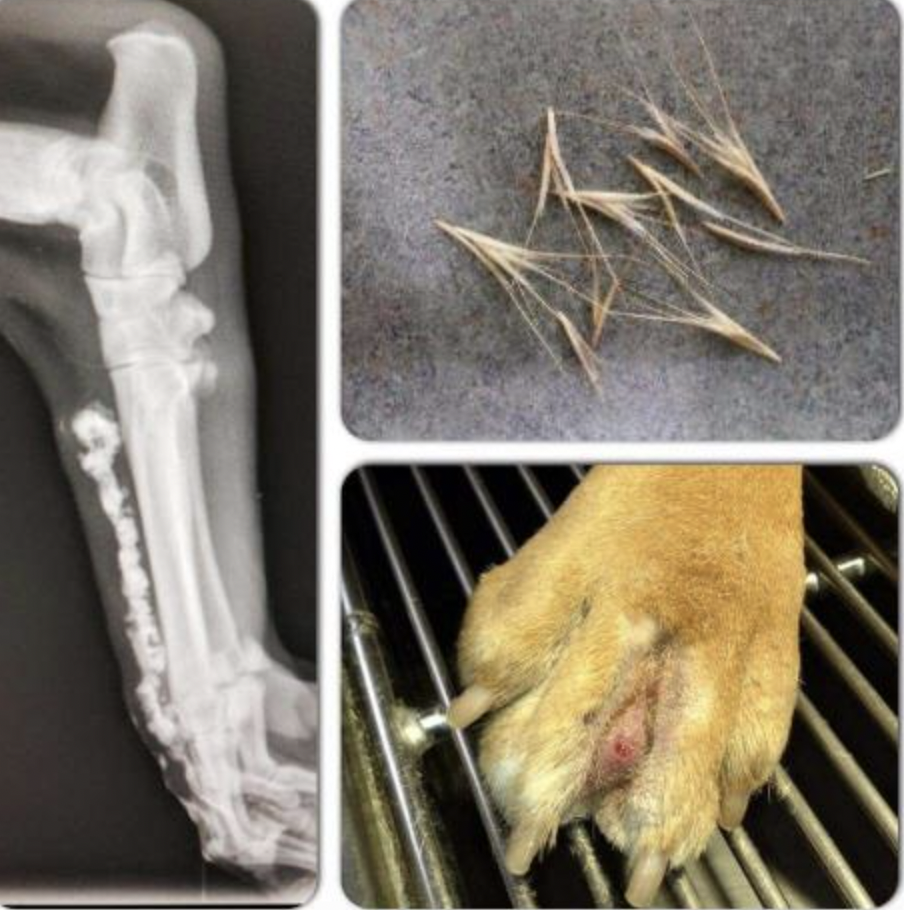This Silent Killer May Be Lurking In Your Dog’s Environment. Protect Your Furry Friend from this Unseen Danger
Last spring, Kobe, our beloved dog, fell victim to the dreaded foxtails – a grass-like weed that releases barbed seed heads, causing havoc in the bodies of our furry friends. It started with Kobe showing some discomfort in his front right paw. But within a day, his wrist had swelled up alarmingly, and we knew we had to take action.
We rushed him to the vet, hoping for a quick fix. But what we didn’t know was that foxtails are insidious, sneaking their way into any part of a pet’s body, from their eyes, ears, nose, mouth, to their skin. The vet couldn’t find the foxtail, so we were told to keep an eye on Kobe and bring him back if things got worse.

Days went by, and despite our best efforts to keep Kobe from chewing on his wrist, the situation worsened. His wrist started oozing, and we could see puncture marks from his incessant chewing. Back to the vet we went, and this cycle repeated several times, with Kobe constantly escaping from his cone despite our best efforts to prevent it.
But, we realized that Kobe’s health was deteriorating rapidly. He refused to eat, making it impossible to give him his heart medication. His overall demeanor was bleak, and he had a fever, clearly battling a severe infection.
Putting Kobe under anesthesia for surgery could be risky due to his heart condition. So we made the decision to take him to a specialized hospital in Los Angeles, where his cardiologist could oversee the procedure if complications arose. It was a gamble, but we had no choice.
At the hospital, the news was both good and bad. The foxtail couldn’t be found, and our only option was to try antibiotics and warm epsom salt soaks to encourage Kobe’s body to push out the foxtail naturally. He was now on eight different medications, including an appetite stimulant to coax him to eat.

We anxiously waited and watched, hoping for signs of improvement. Kobe started showing signs of improvement in about a week and his wrist slowly healed over the course of several months, but there were setbacks as he managed to chew open the wound a few more times. It was a harrowing and exhausting ordeal for both Kobe and us, and we wouldn’t wish it on anyone.
Determined to prevent a repeat of this nightmare, we took action. We sprayed our property with a potent blend of vinegar and salt to keep weeds, including foxtails, at bay. We mow our lawn diligently and fenced off a smaller portion of our property, covering it with mulch to create a foxtail-free zone for our dogs. We even plan to add clover as a ground covering in the future to further discourage foxtail growth.
“Lesson Learned: Opting for a Virtual Vet Could Have Saved Us Many Vet Visits, Hassle, and money. We have since corrected that mistake and now have an active membership where we can contact a vet everyday if needed.”
Rocky Kanaka, Kobe’s Dad
As we reflect on the thousands of dollars and countless sleepless nights we spent on vet care for this preventable mistake, we are determined to spread awareness about the dangers of foxtails for dogs and cats. We urge everyone to take precautions, be vigilant, and protect their furry companions from this insidious threat. Let’s keep our beloved pets safe and healthy, and spare them the agony of battling foxtails.

Foxtails & Dogs FAQs
What is a foxtail in dogs and are they dangerous?
Foxtails are grass-like weeds that bloom in spring and release barbed seed heads. They can work their way into any part of a dog’s body, including eyes, ears, nose, mouth, and skin, causing serious infections or even death if left untreated.
How can I protect my dog from foxtails?
To protect your dog from foxtails, avoid areas where foxtails are abundant, such as overgrown fields or meadows. Keep your lawn and property well-maintained and regularly inspect your dog’s coat, paws, ears, and other vulnerable areas after spending time outdoors.
What are the signs that my dog may have a foxtail embedded in their body?
Signs that your dog may have a foxtail embedded in their body include limping, swelling, redness, discharge, excessive licking or chewing, sneezing, coughing, or difficulty breathing.
Can foxtails be removed at home?
It is not recommended to try and remove foxtails at home, as they can be difficult to locate and extract properly. Attempting to remove foxtails without proper tools and techniques may result in further injury or complications. Always seek veterinary care if you suspect your dog has a foxtail.
What should I do if I suspect my dog has a foxtail?
If you suspect your dog has a foxtail, it’s important to seek veterinary care as soon as possible. A veterinarian will have the proper tools and expertise to locate and safely remove the foxtail to prevent further complications.
How can I prevent my dog from ingesting foxtails?
To prevent your dog from ingesting foxtails, avoid letting them chew on or ingest grass, especially in areas where foxtails are present. Keep your dog’s environment clean and free from foxtails, and discourage them from chewing on grass or other plant materials.
Can foxtails be fatal to dogs?
Yes, foxtails can be fatal to dogs if left untreated. Foxtails can migrate through a dog’s body and cause serious infections or damage to internal organs if not removed promptly.
How can I keep my dog safe during foxtail season?
During foxtail season, it’s important to regularly inspect your dog’s coat, paws, ears, and other vulnerable areas after outdoor activities. Avoid areas with tall grass or foxtails, and consider using protective gear such as boots or a foxtail-resistant coat for your dog.
Can grooming practices help prevent foxtail injuries?
Yes, regular grooming practices such as brushing your dog’s coat and trimming their hair can help prevent foxtail injuries. Keeping your dog’s coat clean and well-maintained can reduce the risk of foxtails becoming embedded in their fur or skin.
What should I do if my dog has a history of foxtail injuries?
If your dog has a history of foxtail injuries, it’s important to take extra precautions to protect them. Avoid areas with foxtails, use protective gear, and maintain good grooming practices. Regularly check your dog for signs of foxtail injuries and seek veterinary care if needed.
Which areas in the United States are foxtails most prevalent?
Foxtails are commonly found in dry, grassy regions, particularly in the western United States. States such as California, Oregon, Washington, Nevada, Idaho, and parts of Arizona, Utah, and Colorado are known to have high populations of foxtails. However, foxtails can also be found in other regions of the United States where dry grasses and weeds are present.
How can foxtails affect my dog’s health?
Foxtails can cause a range of health issues in dogs, including infections, abscesses, pain, discomfort, inflammation, and potentially life-threatening complications. Foxtails can migrate through a dog’s body and may require invasive surgical procedures for removal, leading to additional risks and costs.
What are the signs that my dog may have a foxtail injury?
Signs of a foxtail injury in a dog may include persistent licking or chewing at a specific area, swelling, redness, discharge, sneezing, coughing, difficulty breathing, pawing at the face or ears, and general discomfort or pain. If you notice any of these signs, seek veterinary attention immediately.
How can I protect my dog’s ears from foxtails?
To protect your dog’s ears from foxtails, keep the ears clean and free of excessive hair. If your dog has long ears, consider regular grooming or trimming to minimize the risk of foxtail entry. During walks, avoid areas with tall grasses or weeds that can easily lodge foxtails in your dog’s ears.
Can foxtails be found in other parts of my dog’s body besides the ears?
Yes, foxtails can be found in various parts of a dog’s body, including eyes, nose, mouth, paws, and skin. Regularly inspect your dog’s entire body, paying close attention to areas with thin or exposed skin, and promptly remove any foxtails to prevent potential complications.
What should I do if I suspect my dog has a foxtail injury?
If you suspect that your dog has a foxtail injury, do not attempt to remove it yourself, as improper removal can cause further complications. Seek immediate veterinary attention for proper diagnosis and treatment. Your vet may need to sedate or anesthetize your dog to safely locate and remove the foxtail.
Are certain dog breeds more susceptible to foxtail injuries?
While all dogs are at risk of foxtail injuries, some dog breeds with certain coat types, such as those with long ears, curly hair, or dense fur, may be more susceptible. Breeds such as Cocker Spaniels, Shih Tzus, and Retrievers are known to have a higher risk
How do I know if a foxtail in dog’s paw?
Signs of a foxtail in a dog’s paw may include limping, swelling, redness, or discharge. If you notice these symptoms, it’s important to seek veterinary attention promptly.
Can a foxtail in my dog’s paw cause serious health issues?
Yes, a foxtail in a dog’s paw can cause serious health issues such as infection, abscesses, and even systemic infection if left untreated. It’s crucial to remove foxtails from your dog’s paw as soon as possible to prevent complications.
Can I use Epsom salt as a treatment for my dog’s paw with a foxtail?
As a foxtail dog paw treatment – epsom salt of course it’s best to consult with your veterinarian but Epsom salt can be used as a soothing soak for your dog’s paw, potentially helping to reduce inflammation and promote healing in certain cases of foxtail or other paw-related issues.
